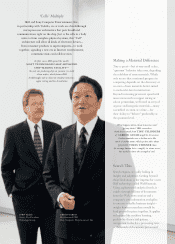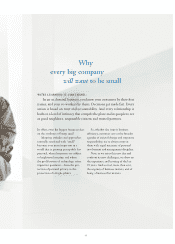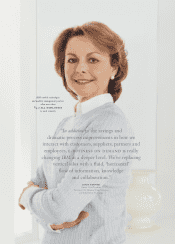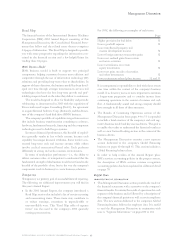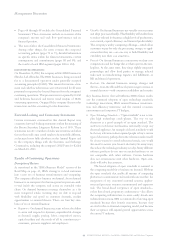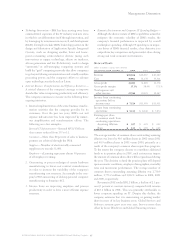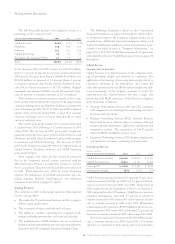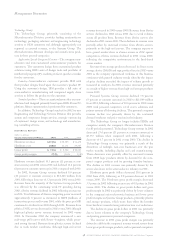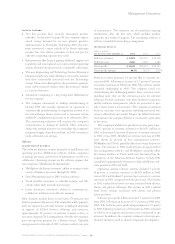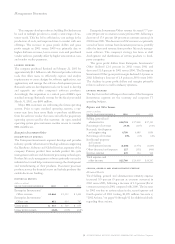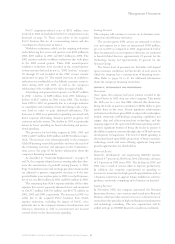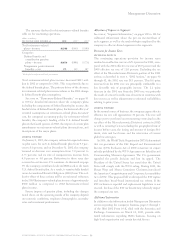IBM 2002 Annual Report Download - page 45
Download and view the complete annual report
Please find page 45 of the 2002 IBM annual report below. You can navigate through the pages in the report by either clicking on the pages listed below, or by using the keyword search tool below to find specific information within the annual report.
Road Map
The financial section of the International Business Machines
Corporation (IBM) 2002 Annual Report consisting of this
Management Discussion, the Consolidated Financial State-
ments that follow and the related notes thereto comprises
64 pages of information. This Road Map is designed to provide
you with some perspective regarding the information con-
tained in the financial section and a few helpful hints for
reading these 64 pages.
IBM’s Business Model
IBM’s business model is built to support two principal
components: helping customers become more efficient and
competitive through the use of information technology (IT)
solutions; and providing long-term value to shareholders. In
support of these objectives, the business model has been devel-
oped over time through strategic investments in services and
technologies that have the best long-term growth and prof-
itability prospects based on the value they deliver to customers.
The model is designed to allow for flexibility and periodic
rebalancing, as demonstrated in 2002 with the acquisition of
PricewaterhouseCoopers Consulting (PwCC), the agreement
to acquire Rational Software Corp. (Rational), and the divesti-
ture of the company’s hard disk drive (HDD) business.
The company’s portfolio of capabilities ranges from services
that include business transformation consulting to software,
hardware, fundamental research, financing and the component
technologies used to build larger systems.
In terms of financial performance, this breadth of capabil-
ities generally results in less volatile returns, because each
capability has unique financial attributes. Some involve con-
tractual long-term cash and income streams while others
involve cyclical transactional-based sales. Each performs
differently in strong and weak economic environments.
In terms of marketplace performance
—
i.e., the ability to
deliver customer value
—
it is important to understand that the
fundamental strength of this business model is not found in the
breadth of the portfolio alone, but in the way the company’s
components work in harmony to create business solutions.
Transparency
Transparency is a primary goal of successful financial reporting.
The following are additional improvements you will find in
this year’s Annual Report.
■
In the 2001 Annual Report, the company introduced a
Road Map section that included a list of certain recurring
and nonrecurring items. These items may contribute to
or reduce earnings, sometimes in unpredictable or
uncontrollable ways. This “Road Map table of expense
items” was also used in the company’s 2002 quarterly
earnings presentations.
For 2002, the following are examples of such items:
Page
Higher provision for bad debts 51
Lower goodwill expense 51
Lower intellectual property and
custom development income 52
Lower foreign currency transaction gains 52
Lower net realized gains from certain
real estate activities 52
Lower writedowns on certain
equity investments 52
Lower net gains on sales of securities
and other investments 52
Lower retirement-related plans income 52 and 53
It is management’s responsibility to deal with these events
over time within the context of the company’s business
model. It is, however, just as or more important to maintain
a longer-term perspective and to consider income from
continuing operations in the context of revenue and cash
flow. A fundamentally sound and strong company should
have strength in all three of these measures.
■
The Results of Continuing Operations section of the
Management Discussion from pages 44 to 53 is expanded
to include a brief overview of the company’s and each seg-
ment’s business model and key success drivers. The goal is
to enable the reader to understand the historical results as
well as a new forward-looking section in the context of the
business drivers.
■
The Management Discussion contains a new separate
section dedicated to the company’s Global Financing
business on pages 60 through 63. This section includes a
Global Financing balance sheet.
■
In order to help readers of the Annual Report place
IBM’s services accounting policies in the proper context,
the description of IBM’s services revenue recognition
accounting policies has been explained in additional detail
on page 70.
Helpful Hints
organization of information
■
This Management Discussion section provides the reader of
the financial statements with a narrative on the company’s
financial results. It contains the results of operations for each
segment of the business and is followed by a description of
the company’s financial position as well as certain employee
data. The new section dedicated to the company’s Global
Financing business follows the employee data. It is useful
to read the Management Discussion in conjunction with
note x, “Segment Information,” on pages 100 to 104.
Management Discussion
43
international business machines corporation and Subsidiary Companies


